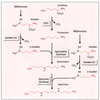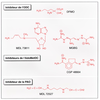| dc.contributor.author | Seiler, N | fr_FR |
| dc.contributor.author | Moulinoux, JP | fr_FR |
| dc.date.accessioned | 2012-07-16T10:40:55Z | |
| dc.date.available | 2012-07-16T10:40:55Z | |
| dc.date.issued | 1996 | fr_FR |
| dc.identifier.citation | Seiler, N ; Moulinoux, JP, Les polyamines présentent-elles actuellement un intérêt dans le traitement du cancer, Med Sci (Paris), 1996, Vol. 12, N° 6-7; p.745-55 | fr_FR |
| dc.identifier.issn | 1958-5381 | fr_FR |
| dc.identifier.uri | http://hdl.handle.net/10608/815 | |
| dc.description.abstract | Le métabolisme des polyamines étant fortement activé dans
les cellules cancéreuses, l’inhibition de la synthèse de ces
molécules a constitué une cible pour l’industrie pharmaceutique.
Mais une succession d’échecs a rendu sceptique
quant à cette voie thérapeutique. En fait, l’inhibition de
l’anabolisme intracellulaire des polyamines doit être couplée
à une réduction de leur absorption intestinale pour
empêcher la progression tumorale. Associés aux médicaments
anticancéreux usuels, les inhibiteurs de la synthèse
des polyamines potentialisent leurs effets. Récemment des
analogues de polyamines mimant les polyamines naturelles
sans pour autant être capables d’en assumer les fonctions,
se sont révélés actifs vis-à-vis de la croissance tumorale in
vivo. Enfin, du fait d’un système de transport transmembranaire
spécifique, certains analogues de polyamines s’accumulent
préférentiellement dans le tissu tumoral. Cette notion
a suscité la synthèse de molécules cytotoxiques
couplées à une polyamine, ce qui devrait améliorer leur ciblage
tumoral et corrélativement une réduction de leurs effets
secondaires toxiques. Il n’existe donc plus d’argument
objectif permettant d’écarter le métabolisme des polyamines
du champ des recherches à visée anticancéreuse. | fr |
| dc.description.abstract | The designations of the natural polyamines, putrescine, spermidine and spermine signal sources of their first discovery. They have contributed considerably to the neglection of this class of biogenic amines with undoubted basic functions in cell growth and proliferation. Early clinical trials with polyamine biosynthesis inhibitors were mostly unsuccessful, as is evident now, due to the lack of understanding of how the polyamines are regulated in the vertebrate organisms. During the last decade our knowledge of polyamine metabolism has improved to the extent that the failure of the clinical trials, as well as the modest success of the attempts to use polyamines of body fluids as tumor markers, can be rationalized. It is evident now that in order to prevent tumors from growing, polyamine biosynthesis inhibition has to be combined with means suitable to prevent at least the utilization of exogenous polyamines by the tumor. Systematic polyamine deprivation, especially in combination with the administration of well established cytotoxic drugs, improves anticancer therapy. Polyamine analogs have been synthesized which mimic some polyamine functions without, however, supporting cell growth. These new compounds promise a new approach in;cancer therapy. Since polyamines are taken up by cells via specific transport systems, polyamine analogs can be rather selectively accumulated in tumors. This fact suggested the preparation of cytotoxic compounds with polyamine structure. The enhancement of selectivity and a reduced general toxicity is to be expected from this new class of drugs. Thus, there is no longer an objective argument against the use of polyamine derivatives, and biosynthesis inhibitors in anticancer therapy. | en |
| dc.language.iso | fr | fr_FR |
| dc.publisher | John Libbey Eurotext, Montrouge | fr_FR |
| dc.rights | Article en libre accès | fr |
| dc.rights | Médecine/Sciences - Inserm - SRMS | fr |
| dc.source | M/S. Médecine sciences [revue papier, ISSN : 0767-0974], 1996, Vol. 12, N° 6-7; p.745-55 | fr_FR |
| dc.title | Les polyamines présentent-elles actuellement un intérêt dans le traitement du cancer | fr |
| dc.title.alternative | Why are polyamines of interest to cancerologists?. | fr_FR |
| dc.type | Article | fr_FR |
| dc.contributor.affiliation | Cnrs URA 1529 affiliee a l'Inserm, Laboratoire de biologie cellulaire, Faculte de Medecine de Rennes I, 2 avenue du Professeur-Leon-Bernard,35043 Rennes Cedex; France. | - |
| dc.identifier.doi | 10.4267/10608/815 | |










